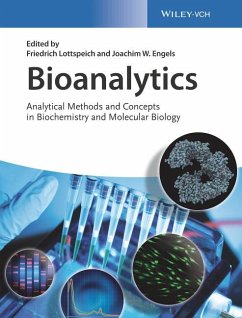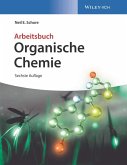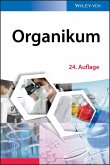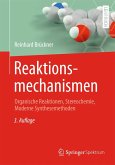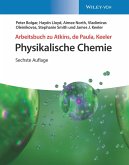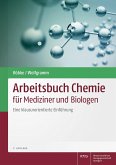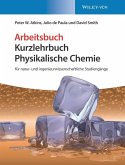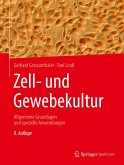Friedrich Lottspeich, Joachim EngelsAnalytical Methods and Concepts in Biochemistry and Molecular Biology
Bioanalytics
Analytical Methods and Concepts in Biochemistry and Molecular Biology
Herausgegeben:Lottspeich, Friedrich; Engels, Joachim
Friedrich Lottspeich, Joachim EngelsAnalytical Methods and Concepts in Biochemistry and Molecular Biology
Bioanalytics
Analytical Methods and Concepts in Biochemistry and Molecular Biology
Herausgegeben:Lottspeich, Friedrich; Engels, Joachim
- Gebundenes Buch
- Merkliste
- Auf die Merkliste
- Bewerten Bewerten
- Teilen
- Produkt teilen
- Produkterinnerung
- Produkterinnerung
Das wohl umfassendste Lehrbuch zu Methoden der modernen Biowissenschaften. Die physikalischen und chemischen Grundlagen sowie die Stärken und Schwächen jeder Methode werden detailliert erläutert. ----------------------------------------
The most comprehensive textbook on methods in modern biosciences on the market. For each method, a thorough introduction into the physical and chemical background as well as a discussion of the strengths and weakness is given.
Andere Kunden interessierten sich auch für
![Organische Chemie Organische Chemie]() Neil E. SchoreOrganische Chemie39,90 €
Neil E. SchoreOrganische Chemie39,90 €![Organikum Organikum]() Klaus SchwetlickOrganikum72,90 €
Klaus SchwetlickOrganikum72,90 €![Reaktionsmechanismen Reaktionsmechanismen]() Reinhard BrücknerReaktionsmechanismen79,99 €
Reinhard BrücknerReaktionsmechanismen79,99 €![Arbeitsbuch Physikalische Chemie Arbeitsbuch Physikalische Chemie]() Peter BolgarArbeitsbuch Physikalische Chemie49,90 €
Peter BolgarArbeitsbuch Physikalische Chemie49,90 €![Arbeitsbuch Chemie für Mediziner und Biologen Arbeitsbuch Chemie für Mediziner und Biologen]() Dirk RöbkeArbeitsbuch Chemie für Mediziner und Biologen32,00 €
Dirk RöbkeArbeitsbuch Chemie für Mediziner und Biologen32,00 €![Kurzlehrbuch Physikalische Chemie Kurzlehrbuch Physikalische Chemie]() Peter W. AtkinsKurzlehrbuch Physikalische Chemie34,90 €
Peter W. AtkinsKurzlehrbuch Physikalische Chemie34,90 €![Zell- und Gewebekultur Zell- und Gewebekultur]() Gerhard GstraunthalerZell- und Gewebekultur59,99 €
Gerhard GstraunthalerZell- und Gewebekultur59,99 €-
-
-
-
-
-
-
-
-
-
-
-
-
Das wohl umfassendste Lehrbuch zu Methoden der modernen Biowissenschaften. Die physikalischen und chemischen Grundlagen sowie die Stärken und Schwächen jeder Methode werden detailliert erläutert.
----------------------------------------
The most comprehensive textbook on methods in modern biosciences on the market. For each method, a thorough introduction into the physical and chemical background as well as a discussion of the strengths and weakness is given.
Hinweis: Dieser Artikel kann nur an eine deutsche Lieferadresse ausgeliefert werden.
----------------------------------------
The most comprehensive textbook on methods in modern biosciences on the market. For each method, a thorough introduction into the physical and chemical background as well as a discussion of the strengths and weakness is given.
Hinweis: Dieser Artikel kann nur an eine deutsche Lieferadresse ausgeliefert werden.
Produktdetails
- Produktdetails
- Verlag: Wiley-VCH
- Artikelnr. des Verlages: 1133919 000
- 1. Auflage
- Seitenzahl: 1134
- Erscheinungstermin: 14. März 2018
- Englisch
- Abmessung: 282mm x 220mm x 55mm
- Gewicht: 2874g
- ISBN-13: 9783527339198
- ISBN-10: 3527339191
- Artikelnr.: 42779960
- Herstellerkennzeichnung
- Wiley-VCH GmbH
- Boschstraße 12
- 69469 Weinheim
- wiley.buha@zeitfracht.de
- Verlag: Wiley-VCH
- Artikelnr. des Verlages: 1133919 000
- 1. Auflage
- Seitenzahl: 1134
- Erscheinungstermin: 14. März 2018
- Englisch
- Abmessung: 282mm x 220mm x 55mm
- Gewicht: 2874g
- ISBN-13: 9783527339198
- ISBN-10: 3527339191
- Artikelnr.: 42779960
- Herstellerkennzeichnung
- Wiley-VCH GmbH
- Boschstraße 12
- 69469 Weinheim
- wiley.buha@zeitfracht.de
Friedrich Lottspeich studied chemistry in Vienna and performed his dissertation at the Max-Planck Institute of Biochemistry in Munich. He received his PhD in biochemistry from the University of Vienna. After habilitation in Munich and Innsbruck, Friedrich Lottspeich was head of the protein analytics group at the Max-Planck Institute of Biochemistry in Munich until his retirement in 2013. His research focused on the development and application of methods for the analysis of proteins. Friedrich Lottspeich is author of more than 750 original publications and is a former President of EUPA and DGPF. He received several international prizes such as the ASAC Pregl Medal 2009, the DGMS Award Mass spectrometry in Life Sciences 2012, the AUPA Life Achievement Award 2014 and the EUPA Juan Pablo Albar Proteomics Award 2016. Joachim W. Engels studied chemistry in Berlin and Munich and received a Ph.D. in Regensburg. He carried out post-doctoral studies at Stanford, did his habilitation in Konstanz and was a visiting scientist at the University of Colorado before joining the company Hoechst in 1981, where he developed gene synthesis. He is a full Professor of Biological Chemistry at the Goethe-University of Frankfurt since 1985. His interests range from chemical biology to bioanalytics. Joachim Engels has served as president of the International Society of Nucleotides and Nucleic Acids (2005/6), held several guest professorships at Chiba Institute, Japan (1989), Hokkaido University, Japan (1998) Shandong University, China (2004), Cady-Ayyad University, Morocco (2010), University Witwatersrand, South Africa (2012). He has authored more than 300 original publications. On retirement, he was chosen Professor Emeritus and he is now President of the Goethe-Wissenschaftliche Gesellschaft (Academy) in Frankfurt.
Part I: PROTEIN ANALYTICS
Protein purification
Protein determination
Enzymatic activity tests
Microcalorimetry
Imunological Techniques
Cheminal modification of proteins and protein complexes
Spectroscopy
Light microscopy - Imaging
Cleavage of proteins
Chromatographic techniques
Electrophoretic techniques
Capillary electrophoresis
Amino acid analysis
Protein seqeunce analysis
Mass spectrometry
Protein protein interactions
The Two-Hybrid System
TAP-Tagging and Purification of Protein Complexes
Analyzing Interactions In Vitro: GST-Pulldown
Surface Plasmon Resonance Spectroscopy
Fluorescence Resonance Energy Transfer (FRET)
Analytical Ultracentrifugation
Analytical Ultracentrifugation
Biosensors
Part II: 3D STRUCTURE DETERMINATION
NMR
EPR
Electron microscopy
Atomic force microscopy
X-ray structrure analysis
Part III: PEPTIDES, CARBOHYDRATES, AND LIPIDS
Analysis of synthetic peptides
Carbohydrate analysis
Lipid analysis
Analysis of posttranslational modifications
Part IV: NUCLEIC ACID ANALYTICS
Isolation and Purification of Nucleic Acids
Analysis of Nucleic Acids
Restriction analysis
Electrophoresis
LC-MS of Oligonucleotides
LC-MS of Oligonucleotides
Techniques for the Hybridization and Detection of Nucleic Acids
Polymerase chain reaction
DNA sequencing
Analysis of epigenetic modifications
Protein nucleic acid interactions
Part V: FUNCTIONAL AND SYSTEMS ANALYTICS
Sequence analysis by bioinformatics
Analysis of promotor strength
Hybridization of fluorescent DNA for genome analysis in molecular cytogenetic
Physical and genetic mapping of genomes
DNA microarray techmology
The Use of oligonucleotides as tools in cell biology
Proteome analysis
Metabolomics and peptidomics
Interactomics - systematic protein protein interactions
Chemical Biology
Toponome Analysis
Mass Spectrometric Imaging
Protein purification
Protein determination
Enzymatic activity tests
Microcalorimetry
Imunological Techniques
Cheminal modification of proteins and protein complexes
Spectroscopy
Light microscopy - Imaging
Cleavage of proteins
Chromatographic techniques
Electrophoretic techniques
Capillary electrophoresis
Amino acid analysis
Protein seqeunce analysis
Mass spectrometry
Protein protein interactions
The Two-Hybrid System
TAP-Tagging and Purification of Protein Complexes
Analyzing Interactions In Vitro: GST-Pulldown
Surface Plasmon Resonance Spectroscopy
Fluorescence Resonance Energy Transfer (FRET)
Analytical Ultracentrifugation
Analytical Ultracentrifugation
Biosensors
Part II: 3D STRUCTURE DETERMINATION
NMR
EPR
Electron microscopy
Atomic force microscopy
X-ray structrure analysis
Part III: PEPTIDES, CARBOHYDRATES, AND LIPIDS
Analysis of synthetic peptides
Carbohydrate analysis
Lipid analysis
Analysis of posttranslational modifications
Part IV: NUCLEIC ACID ANALYTICS
Isolation and Purification of Nucleic Acids
Analysis of Nucleic Acids
Restriction analysis
Electrophoresis
LC-MS of Oligonucleotides
LC-MS of Oligonucleotides
Techniques for the Hybridization and Detection of Nucleic Acids
Polymerase chain reaction
DNA sequencing
Analysis of epigenetic modifications
Protein nucleic acid interactions
Part V: FUNCTIONAL AND SYSTEMS ANALYTICS
Sequence analysis by bioinformatics
Analysis of promotor strength
Hybridization of fluorescent DNA for genome analysis in molecular cytogenetic
Physical and genetic mapping of genomes
DNA microarray techmology
The Use of oligonucleotides as tools in cell biology
Proteome analysis
Metabolomics and peptidomics
Interactomics - systematic protein protein interactions
Chemical Biology
Toponome Analysis
Mass Spectrometric Imaging
Part I: PROTEIN ANALYTICS
Protein purification
Protein determination
Enzymatic activity tests
Microcalorimetry
Imunological Techniques
Cheminal modification of proteins and protein complexes
Spectroscopy
Light microscopy - Imaging
Cleavage of proteins
Chromatographic techniques
Electrophoretic techniques
Capillary electrophoresis
Amino acid analysis
Protein seqeunce analysis
Mass spectrometry
Protein protein interactions
The Two-Hybrid System
TAP-Tagging and Purification of Protein Complexes
Analyzing Interactions In Vitro: GST-Pulldown
Surface Plasmon Resonance Spectroscopy
Fluorescence Resonance Energy Transfer (FRET)
Analytical Ultracentrifugation
Analytical Ultracentrifugation
Biosensors
Part II: 3D STRUCTURE DETERMINATION
NMR
EPR
Electron microscopy
Atomic force microscopy
X-ray structrure analysis
Part III: PEPTIDES, CARBOHYDRATES, AND LIPIDS
Analysis of synthetic peptides
Carbohydrate analysis
Lipid analysis
Analysis of posttranslational modifications
Part IV: NUCLEIC ACID ANALYTICS
Isolation and Purification of Nucleic Acids
Analysis of Nucleic Acids
Restriction analysis
Electrophoresis
LC-MS of Oligonucleotides
LC-MS of Oligonucleotides
Techniques for the Hybridization and Detection of Nucleic Acids
Polymerase chain reaction
DNA sequencing
Analysis of epigenetic modifications
Protein nucleic acid interactions
Part V: FUNCTIONAL AND SYSTEMS ANALYTICS
Sequence analysis by bioinformatics
Analysis of promotor strength
Hybridization of fluorescent DNA for genome analysis in molecular cytogenetic
Physical and genetic mapping of genomes
DNA microarray techmology
The Use of oligonucleotides as tools in cell biology
Proteome analysis
Metabolomics and peptidomics
Interactomics - systematic protein protein interactions
Chemical Biology
Toponome Analysis
Mass Spectrometric Imaging
Protein purification
Protein determination
Enzymatic activity tests
Microcalorimetry
Imunological Techniques
Cheminal modification of proteins and protein complexes
Spectroscopy
Light microscopy - Imaging
Cleavage of proteins
Chromatographic techniques
Electrophoretic techniques
Capillary electrophoresis
Amino acid analysis
Protein seqeunce analysis
Mass spectrometry
Protein protein interactions
The Two-Hybrid System
TAP-Tagging and Purification of Protein Complexes
Analyzing Interactions In Vitro: GST-Pulldown
Surface Plasmon Resonance Spectroscopy
Fluorescence Resonance Energy Transfer (FRET)
Analytical Ultracentrifugation
Analytical Ultracentrifugation
Biosensors
Part II: 3D STRUCTURE DETERMINATION
NMR
EPR
Electron microscopy
Atomic force microscopy
X-ray structrure analysis
Part III: PEPTIDES, CARBOHYDRATES, AND LIPIDS
Analysis of synthetic peptides
Carbohydrate analysis
Lipid analysis
Analysis of posttranslational modifications
Part IV: NUCLEIC ACID ANALYTICS
Isolation and Purification of Nucleic Acids
Analysis of Nucleic Acids
Restriction analysis
Electrophoresis
LC-MS of Oligonucleotides
LC-MS of Oligonucleotides
Techniques for the Hybridization and Detection of Nucleic Acids
Polymerase chain reaction
DNA sequencing
Analysis of epigenetic modifications
Protein nucleic acid interactions
Part V: FUNCTIONAL AND SYSTEMS ANALYTICS
Sequence analysis by bioinformatics
Analysis of promotor strength
Hybridization of fluorescent DNA for genome analysis in molecular cytogenetic
Physical and genetic mapping of genomes
DNA microarray techmology
The Use of oligonucleotides as tools in cell biology
Proteome analysis
Metabolomics and peptidomics
Interactomics - systematic protein protein interactions
Chemical Biology
Toponome Analysis
Mass Spectrometric Imaging

